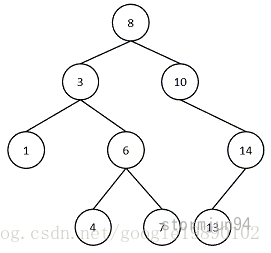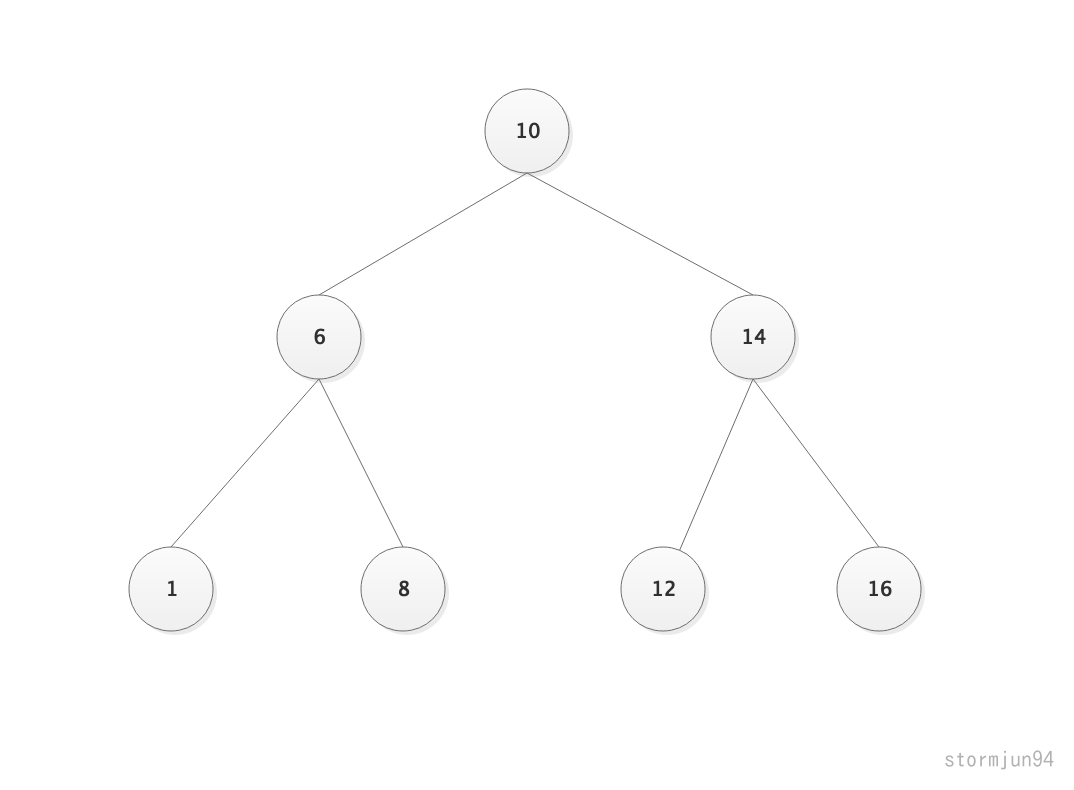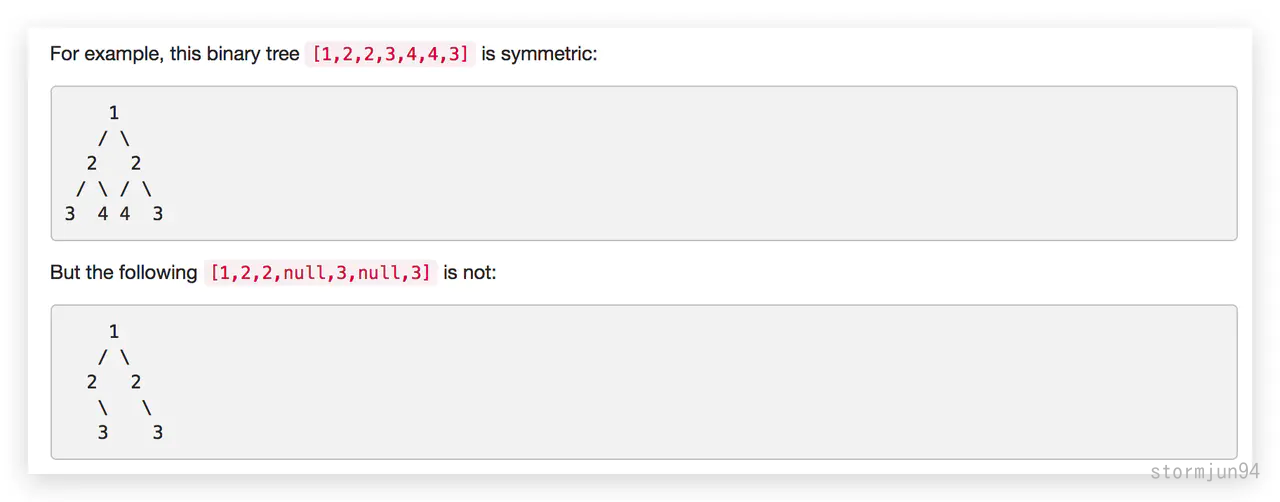前言
前段时间,写了面试必备的一系列文章,反应还不错。有一些读者反馈说,能不能整理一些面试常见的算法。前段时间,我恰好总结了 LeetCode 常见的面试算法题目。
Android 面试必备 - http 与 https 协议
Android 面试必备 - 计算机网络基本知识(TCP,UDP,Http,https)
Android 面试必备 - 系统、App、Activity 启动过程
面试官问, https 真的安全吗,可以抓包吗,如何防止抓包吗
刚开始准备刷算法题目的时候,感觉真的是好难,十道题目有九道是不会的。心中曾一万只草泥马跑过,自己怎么这么辣鸡。

慢慢得,我发现算法也是一个可以通过练习慢慢成长的。
- 首先我们要掌握基本的数据结构,数组,链表,哈希表, Set,二叉树,堆,栈等。你要知道他们有什么优缺点,适应场景是什么,时间复杂度和空间复杂度是多少。而不能知道简单的 API。
- 接着,掌握了这些基本的数据结构之后,一些基本的算法你也要掌握以下,比如快速排序,归并排序,对排序,二分查找。这些基本的一定要掌握,面试当中经常也会问到。
- 分类刷题,我们在力扣上面可以看到,https://leetcode-cn.com/problemset/algorithms/ ,刷题是可以按标签来的。比如链表,数组,二分查找,二叉树,动态规划等
- 学好算法不是一日之功,需要长期的积累。建议的做法是每天做一两道题,题目不在多,贵在于理解。坚持一两个月,你会发现你的感觉逐渐好起来了
废话不多说了,开始进入今天的正文,LeetCode链表知识点&题型总结
二叉树的概念
二叉树(Binary Tree)是包含n个节点的有限集合,该集合或者为空集(此时,二叉树称为空树),或者由一个根节点和两棵互不相交的、分别称为根节点的左子树和右子树的二叉树组成。
一棵典型的二叉树如下图所示:

由上述的定义可以看出,二叉树中的节点至多包含两棵子树,分别称为左子树和右子树,而左子树和右子树又分别至多包含两棵子树。由上述的定义,二叉树的定义是一种递归的定义。
二叉树种类
满二叉树
对于一棵二叉树,如果每一个非叶子节点都存在左右子树,并且二叉树中所有的叶子节点都在同一层中,这样的二叉树称为满二叉树。
完全二叉树
对于一棵具有n个节点的二叉树按照层次编号,同时,左右子树按照先左后右编号,如果编号为i的节点与同样深度的满二叉树中编号为i的节点在二叉树中的位置完全相同,则这棵二叉树称为完全二叉树。
二叉排序树:
又称二叉查找树(Binary Search Tree),亦称二叉搜索树。二叉排序树或者是一棵空树,或者是具有下列性质的二叉树:
- 若左子树不空,则左子树上所有结点的值均小于它的根结点的值;
- 若右子树不空,则右子树上所有结点的值均大于或等于它的根结点的值;
- 左、右子树也分别为二叉排序树;
- 没有键值相等的节点
二分查找的时间复杂度是O(log(n)),最坏情况下的时间复杂度是O(n)(相当于顺序查找)
平衡二叉树:
又称 AVL 树。平衡二叉树是二叉搜索树的进化版,所谓平衡二叉树指的是,左右两个子树的高度差的绝对值不超过 1。
红黑树:
红黑树是每个节点都带颜色的树,节点颜色或是红色或是黑色,红黑树是一种查找树。红黑树有一个重要的性质,从根节点到叶子节点的最长的路径不多于最短的路径的长度的两倍。对于红黑树,插入,删除,查找的复杂度都是O(log N)。
哈夫曼树:
给定n个权值作为n的叶子结点,构造一棵二叉树,若带权路径长度达到最小,称这样的二叉树为最优二叉树,也称为哈夫曼树(Huffman tree)。
遍历方式
二叉树主要有四种遍历方式
- 先序(先根)遍历:即先访问根节点,再访问左孩子和右孩子
- 中序遍历:先访问做孩子,再访问根节点和右孩子
- 后序遍历:先访问左孩子,再访问右孩子,再访问根节点
- 层次遍历:按照所在层数,从下往上遍历
前提:这里先给出测试中的二叉树结构,如下图所示

该二叉树对应的几种遍历方式的结果顺序:
- 先序遍历:10->6->4->8->14->12->16
- 中序遍历:4->6->8->10->12->14->16
- 后序遍历:4->8->6->12->16->14->10
- 层次遍历:10->6->14->4->8->12->16
递归
一棵树要么是空树,要么有两个指针,每个指针指向一棵树。树是一种递归结构,很多树的问题可以使用递归来处理。
1. 树的高度
1.0 求二叉树的最大层数(最大深度)
104. Maximum Depth of Binary Tree (Easy)
这道题目的解法其实很简单
- 如果二叉树为空,二叉树的深度为0
- 如果二叉树不为空,二叉树的深度 = max(左子树深度, 右子树深度) + 1
public int maxDepth(TreeNode root) {
if (root == null) return 0;
return Math.max(maxDepth(root.left), maxDepth(root.right)) + 1;
}
1.1 二叉树的最小深度
LeetCode:Minimum Depth of Binary Tree
给定一个二叉树,找出其最小深度。
最小深度是从根节点到最近叶子节点的最短路径上的节点数量。

class Solution {
public int minDepth(TreeNode root) {
if(root == null)
return 0;
int left = minDepth(root.left);
int right = minDepth(root.right);
return (left == 0 || right == 0) ? left + right + 1 : Math.min(left, right) + 1;
}
}
2. 平衡树
110. Balanced Binary Tree (Easy)
3
/
9 20
/
15 7
思路
平衡树左右子树高度差都小于等于 1
private boolean result = true;
public boolean isBalanced(TreeNode root) {
maxDepth(root);
return result;
}
public int maxDepth(TreeNode root) {
if (root == null) return 0;
int l = maxDepth(root.left);
int r = maxDepth(root.right);
if (Math.abs(l - r) > 1) result = false;
return 1 + Math.max(l, r);
}
3. 两节点的最长路径
543. Diameter of Binary Tree (Easy)
Input:
1
/
2 3
/
4 5
Return 3, which is the length of the path [4,2,1,3] or [5,2,1,3].
private int max = 0;
public int diameterOfBinaryTree(TreeNode root) {
depth(root);
return max;
}
private int depth(TreeNode root) {
if (root == null) return 0;
int leftDepth = depth(root.left);
int rightDepth = depth(root.right);
max = Math.max(max, leftDepth + rightDepth);
return Math.max(leftDepth, rightDepth) + 1;
}
4. 翻转树
226. Invert Binary Tree (Easy)
public TreeNode invertTree(TreeNode root) {
if (root == null) return null;
TreeNode left = root.left; // 后面的操作会改变 left 指针,因此先保存下来
root.left = invertTree(root.right);
root.right = invertTree(left);
return root;
}
5. 归并两棵树
617. Merge Two Binary Trees (Easy)
Input:
Tree 1 Tree 2
1 2
/ /
3 2 1 3
/
5 4 7
Output:
3
/
4 5
/
5 4 7
public TreeNode mergeTrees(TreeNode t1, TreeNode t2) {
if (t1 == null && t2 == null) return null;
if (t1 == null) return t2;
if (t2 == null) return t1;
TreeNode root = new TreeNode(t1.val + t2.val);
root.left = mergeTrees(t1.left, t2.left);
root.right = mergeTrees(t1.right, t2.right);
return root;
}
6. 判断路径和是否等于一个数
Leetcdoe : 112. Path Sum (Easy)
Given the below binary tree and sum = 22,
5
/
4 8
/ /
11 13 4
/
7 2 1
return true, as there exist a root-to-leaf path 5->4->11->2 which sum is 22.
路径和定义为从 root 到 leaf 的所有节点的和。
public boolean hasPathSum(TreeNode root, int sum) {
if (root == null) return false;
if (root.left == null && root.right == null && root.val == sum) return true;
return hasPathSum(root.left, sum - root.val) || hasPathSum(root.right, sum - root.val);
}
7. 统计路径和等于一个数的路径数量
437. Path Sum III (Easy)
root = [10,5,-3,3,2,null,11,3,-2,null,1], sum = 8
10
/
5 -3
/
3 2 11
/
3 -2 1
Return 3. The paths that sum to 8 are:
1. 5 -> 3
2. 5 -> 2 -> 1
3. -3 -> 11
路径不一定以 root 开头,也不一定以 leaf 结尾,但是必须连续。
public int pathSum(TreeNode root, int sum) {
if (root == null) return 0;
int ret = pathSumStartWithRoot(root, sum) + pathSum(root.left, sum) + pathSum(root.right, sum);
return ret;
}
private int pathSumStartWithRoot(TreeNode root, int sum) {
if (root == null) return 0;
int ret = 0;
if (root.val == sum) ret++;
ret += pathSumStartWithRoot(root.left, sum - root.val) + pathSumStartWithRoot(root.right, sum - root.val);
return ret;
}
8. 子树
572. Subtree of Another Tree (Easy)
Given tree s:
3
/
4 5
/
1 2
Given tree t:
4
/
1 2
Return true, because t has the same structure and node values with a subtree of s.
Given tree s:
3
/
4 5
/
1 2
/
0
Given tree t:
4
/
1 2
Return false.
public boolean isSubtree(TreeNode s, TreeNode t) {
if (s == null) return false;
return isSubtreeWithRoot(s, t) || isSubtree(s.left, t) || isSubtree(s.right, t);
}
private boolean isSubtreeWithRoot(TreeNode s, TreeNode t) {
if (t == null && s == null) return true;
if (t == null || s == null) return false;
if (t.val != s.val) return false;
return isSubtreeWithRoot(s.left, t.left) && isSubtreeWithRoot(s.right, t.right);
}
9. 树的对称
101. Symmetric Tree (Easy)

public boolean isSymmetric(TreeNode root) {
if (root == null) return true;
return isSymmetric(root.left, root.right);
}
private boolean isSymmetric(TreeNode t1, TreeNode t2) {
if (t1 == null && t2 == null) return true;
if (t1 == null || t2 == null) return false;
if (t1.val != t2.val) return false;
return isSymmetric(t1.left, t2.right) && isSymmetric(t1.right, t2.left);
}
10 求二叉树的镜像

class Solution {
public TreeNode invertTree(TreeNode root) {
if(root == null)
return root;
// 先保存最节点,因为 invertTree 已经变化了
TreeNode node = root.left;
root.left = invertTree(root.right);
root.right = invertTree(node);
return root;
}
}
11. 最小路径
111. Minimum Depth of Binary Tree (Easy)
树的根节点到叶子节点的最小路径长度
public int minDepth(TreeNode root) {
if (root == null) return 0;
int left = minDepth(root.left);
int right = minDepth(root.right);
if (left == 0 || right == 0) return left + right + 1;
return Math.min(left, right) + 1;
}
层次遍历
使用 BFS 进行层次遍历。不需要使用两个队列来分别存储当前层的节点和下一层的节点,因为在开始遍历一层的节点时,当前队列中的节点数就是当前层的节点数,只要控制遍历这么多节点数,就能保证这次遍历的都是当前层的节点。
1. 二叉树的层序遍历
给定二叉树,返回其节点值的自下而上级别顺序遍历。
class Solution {
public List<List<Integer>> levelOrderBottom(TreeNode root) {
List<List<Integer>> res = new LinkedList<>();
Queue<TreeNode> queue = new LinkedList<>();
if(root == null)
return res;
queue.add(root);
while(!queue.isEmpty()){
int count = queue.size();
List<Integer> temp = new LinkedList<>();
for(int i=0; i<count; i++){
TreeNode node = queue.poll();
temp.add(node.val);
if(node.left != null)
queue.add(node.left);
if(node.right != null)
queue.add(node.right);
}
// 每次都添加到第一个位置
res.add(0, temp);
}
return res;
}
}
按之字形打印二叉树
请实现一个函数按照之字形打印二叉树,即第一行按照从左到右的顺序打印,第二层按照从右至左的顺序打印,第三行按照从左到右的顺序打印,其他行以此类推。
- 设两个栈,s2存放奇数层,s1存放偶数层
- 遍历s2节点的同时按照左子树、右子树的顺序加入s1,
- 遍历s1节点的同时按照右子树、左子树的顺序加入s2
import java.util.ArrayList;
import java.util.Stack;
/*
public class TreeNode {
int val = 0;
TreeNode left = null;
TreeNode right = null;
public TreeNode(int val) {
this.val = val;
}
}
*/
public class Solution {
public ArrayList<ArrayList<Integer> > Print(TreeNode pRoot) {
ArrayList<ArrayList<Integer> > res = new ArrayList<ArrayList<Integer> >();
Stack<TreeNode> s1 = new Stack<TreeNode>();
Stack<TreeNode> s2 = new Stack<TreeNode>();
int flag = 1;
if(pRoot == null)
return res;
s2.push(pRoot);
ArrayList<Integer> temp = new ArrayList<Integer>();
while(!s1.isEmpty() || !s2.isEmpty()){
if(flag % 2 != 0){
while(!s2.isEmpty()){
TreeNode node = s2.pop();
temp.add(node.val);
if(node.left != null){
s1.push(node.left);
}
if(node.right != null){
s1.push(node.right);
}
}
}
if(flag % 2 == 0){
while(!s1.isEmpty()){
TreeNode node = s1.pop();
temp.add(node.val);
if(node.right != null){
s2.push(node.right);
}
if(node.left != null){
s2.push(node.left);
}
}
}
res.add(new ArrayList<Integer>(temp));
temp.clear();
flag ++;
}
return res;
}
}
前中后序遍历
1
/
2 3
/
4 5 6
- 层次遍历顺序:[1 2 3 4 5 6]
- 前序遍历顺序:[1 2 4 5 3 6]
- 中序遍历顺序:[4 2 5 1 3 6]
- 后序遍历顺序:[4 5 2 6 3 1]
层次遍历使用 BFS 实现,利用的就是 BFS 一层一层遍历的特性;而前序、中序、后序遍历利用了 DFS 实现。
前序、中序、后序遍只是在对节点访问的顺序有一点不同,其它都相同。
① 前序
void dfs(TreeNode root) {
visit(root);
dfs(root.left);
dfs(root.right);
}
② 中序
void dfs(TreeNode root) {
dfs(root.left);
visit(root);
dfs(root.right);
}
③ 后序
void dfs(TreeNode root) {
dfs(root.left);
dfs(root.right);
visit(root);
}
1. 非递归实现二叉树的前序遍历
144. Binary Tree Preorder Traversal (Medium)
public List<Integer> preorderTraversal(TreeNode root) {
List<Integer> ret = new ArrayList<>();
Stack<TreeNode> stack = new Stack<>();
stack.push(root);
while (!stack.isEmpty()) {
TreeNode node = stack.pop();
if (node == null) continue;
ret.add(node.val);
stack.push(node.right); // 先右后左,保证左子树先遍历
stack.push(node.left);
}
return ret;
}
2. 非递归实现二叉树的后序遍历
145. Binary Tree Postorder Traversal (Medium)
前序遍历为 root -> left -> right,后序遍历为 left -> right -> root。可以修改前序遍历成为 root -> right -> left,那么这个顺序就和后序遍历正好相反。
public List<Integer> postorderTraversal(TreeNode root) {
List<Integer> ret = new ArrayList<>();
Stack<TreeNode> stack = new Stack<>();
stack.push(root);
while (!stack.isEmpty()) {
TreeNode node = stack.pop();
if (node == null) continue;
ret.add(node.val);
stack.push(node.left);
stack.push(node.right);
}
Collections.reverse(ret);
return ret;
}
3. 非递归实现二叉树的中序遍历
94. Binary Tree Inorder Traversal (Medium)
public List<Integer> inorderTraversal(TreeNode root) {
List<Integer> ret = new ArrayList<>();
if (root == null) return ret;
Stack<TreeNode> stack = new Stack<>();
TreeNode cur = root;
while (cur != null || !stack.isEmpty()) {
while (cur != null) {
stack.push(cur);
cur = cur.left;
}
TreeNode node = stack.pop();
ret.add(node.val);
cur = node.right;
}
return ret;
}
BST
二叉查找树(BST):根节点大于等于左子树所有节点,小于等于右子树所有节点。
二叉查找树中序遍历有序。
1. 修剪二叉查找树
669. Trim a Binary Search Tree (Easy)
Input:
3
/
0 4
2
/
1
L = 1
R = 3
Output:
3
/
2
/
1
题目描述:只保留值在 L ~ R 之间的节点
public TreeNode trimBST(TreeNode root, int L, int R) {
if (root == null) return null;
if (root.val > R) return trimBST(root.left, L, R);
if (root.val < L) return trimBST(root.right, L, R);
root.left = trimBST(root.left, L, R);
root.right = trimBST(root.right, L, R);
return root;
}
2. 寻找二叉查找树的第 k 个元素
230. Kth Smallest Element in a BST (Medium)
中序遍历解法:
private int cnt = 0;
private int val;
public int kthSmallest(TreeNode root, int k) {
inOrder(root, k);
return val;
}
private void inOrder(TreeNode node, int k) {
if (node == null) return;
inOrder(node.left, k);
cnt++;
if (cnt == k) {
val = node.val;
return;
}
inOrder(node.right, k);
}
递归解法:
public int kthSmallest(TreeNode root, int k) {
int leftCnt = count(root.left);
if (leftCnt == k - 1) return root.val;
if (leftCnt > k - 1) return kthSmallest(root.left, k);
return kthSmallest(root.right, k - leftCnt - 1);
}
private int count(TreeNode node) {
if (node == null) return 0;
return 1 + count(node.left) + count(node.right);
}
3. 把二叉查找树每个节点的值都加上比它大的节点的值
Convert BST to Greater Tree (Easy)
Input: The root of a Binary Search Tree like this:
5
/
2 13
Output: The root of a Greater Tree like this:
18
/
20 13
先遍历右子树。
private int sum = 0;
public TreeNode convertBST(TreeNode root) {
traver(root);
return root;
}
private void traver(TreeNode node) {
if (node == null) return;
traver(node.right);
sum += node.val;
node.val = sum;
traver(node.left);
}
4. 二叉查找树的最近公共祖先
235. Lowest Common Ancestor of a Binary Search Tree (Easy)
_______6______
/
___2__ ___8__
/ /
0 4 7 9
/
3 5
For example, the lowest common ancestor (LCA) of nodes 2 and 8 is 6. Another example is LCA of nodes 2 and 4 is 2, since a node can be a descendant of itself according to the LCA definition.
public TreeNode lowestCommonAncestor(TreeNode root, TreeNode p, TreeNode q) {
if (root.val > p.val && root.val > q.val) return lowestCommonAncestor(root.left, p, q);
if (root.val < p.val && root.val < q.val) return lowestCommonAncestor(root.right, p, q);
return root;
}
5. 二叉树的最近公共祖先
236. Lowest Common Ancestor of a Binary Tree (Medium)
_______3______
/
___5__ ___1__
/ /
6 2 0 8
/
7 4
For example, the lowest common ancestor (LCA) of nodes 5 and 1 is 3. Another example is LCA of nodes 5 and 4 is 5, since a node can be a descendant of itself according to the LCA definition.
public TreeNode lowestCommonAncestor(TreeNode root, TreeNode p, TreeNode q) {
if (root == null || root == p || root == q) return root;
TreeNode left = lowestCommonAncestor(root.left, p, q);
TreeNode right = lowestCommonAncestor(root.right, p, q);
return left == null ? right : right == null ? left : root;
}
6. 从有序数组中构造二叉查找树
108. Convert Sorted Array to Binary Search Tree (Easy)
public TreeNode sortedArrayToBST(int[] nums) {
return toBST(nums, 0, nums.length - 1);
}
private TreeNode toBST(int[] nums, int sIdx, int eIdx){
if (sIdx > eIdx) return null;
int mIdx = (sIdx + eIdx) / 2;
TreeNode root = new TreeNode(nums[mIdx]);
root.left = toBST(nums, sIdx, mIdx - 1);
root.right = toBST(nums, mIdx + 1, eIdx);
return root;
}
7. 根据有序链表构造平衡的二叉查找树
109. Convert Sorted List to Binary Search Tree (Medium)
Given the sorted linked list: [-10,-3,0,5,9],
One possible answer is: [0,-3,9,-10,null,5], which represents the following height balanced BST:
0
/
-3 9
/ /
-10 5
public TreeNode sortedListToBST(ListNode head) {
if (head == null) return null;
if (head.next == null) return new TreeNode(head.val);
ListNode preMid = preMid(head);
ListNode mid = preMid.next;
preMid.next = null; // 断开链表
TreeNode t = new TreeNode(mid.val);
t.left = sortedListToBST(head);
t.right = sortedListToBST(mid.next);
return t;
}
private ListNode preMid(ListNode head) {
ListNode slow = head, fast = head.next;
ListNode pre = head;
while (fast != null && fast.next != null) {
pre = slow;
slow = slow.next;
fast = fast.next.next;
}
return pre;
}
8. 在二叉查找树中寻找两个节点,使它们的和为一个给定值
653. Two Sum IV - Input is a BST (Easy)
Input:
5
/
3 6
/
2 4 7
Target = 9
Output: True
使用中序遍历得到有序数组之后,再利用双指针对数组进行查找。
应该注意到,这一题不能用分别在左右子树两部分来处理这种思想,因为两个待求的节点可能分别在左右子树中。
public boolean findTarget(TreeNode root, int k) {
List<Integer> nums = new ArrayList<>();
inOrder(root, nums);
int i = 0, j = nums.size() - 1;
while (i < j) {
int sum = nums.get(i) + nums.get(j);
if (sum == k) return true;
if (sum < k) i++;
else j--;
}
return false;
}
private void inOrder(TreeNode root, List<Integer> nums) {
if (root == null) return;
inOrder(root.left, nums);
nums.add(root.val);
inOrder(root.right, nums);
}
9. 在二叉查找树中查找两个节点之差的最小绝对值
530. Minimum Absolute Difference in BST (Easy)
Input:
1
3
/
2
Output:
1
利用二叉查找树的中序遍历为有序的性质,计算中序遍历中临近的两个节点之差的绝对值,取最小值。
private int minDiff = Integer.MAX_VALUE;
private TreeNode preNode = null;
public int getMinimumDifference(TreeNode root) {
inOrder(root);
return minDiff;
}
private void inOrder(TreeNode node) {
if (node == null) return;
inOrder(node.left);
if (preNode != null) minDiff = Math.min(minDiff, node.val - preNode.val);
preNode = node;
inOrder(node.right);
}
10. 寻找二叉查找树中出现次数最多的值
501. Find Mode in Binary Search Tree (Easy)
1
2
/
2
return [2].
答案可能不止一个,也就是有多个值出现的次数一样多。
private int curCnt = 1;
private int maxCnt = 1;
private TreeNode preNode = null;
public int[] findMode(TreeNode root) {
List<Integer> maxCntNums = new ArrayList<>();
inOrder(root, maxCntNums);
int[] ret = new int[maxCntNums.size()];
int idx = 0;
for (int num : maxCntNums) {
ret[idx++] = num;
}
return ret;
}
private void inOrder(TreeNode node, List<Integer> nums) {
if (node == null) return;
inOrder(node.left, nums);
if (preNode != null) {
if (preNode.val == node.val) curCnt++;
else curCnt = 1;
}
if (curCnt > maxCnt) {
maxCnt = curCnt;
nums.clear();
nums.add(node.val);
} else if (curCnt == maxCnt) {
nums.add(node.val);
}
preNode = node;
inOrder(node.right, nums);
}
参考文章
小结
如果你想学好算法,建议上面二叉树的题目都刷一下。如果你只是想应付面试,主要看一下高频的面试题目即可。
- 树的递归。比如树的深度,最小深度,树的镜像。
- 二叉树的前序遍历,中序遍历,后续遍历,记住,递归和非递归解法都要会。学会举一反三。
- 二叉树的层序遍历,递归和非递归也都要会。
- 常见的 BST 算法。二叉查找树的最近公共祖先(两个元素的,三个元素的,多个元素呢)。二叉树的最近公共祖先。
如果你觉得对你有所帮助,请帮忙 start
Android_interview github。或者关注我的微信公众号徐公码字
